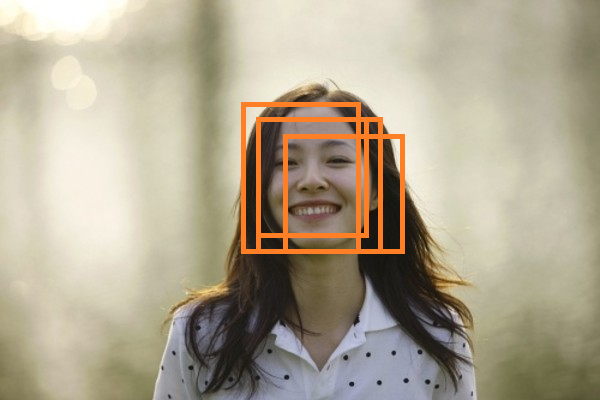object detection[NMS]
非极大抑制,是在对象检测中用的较为频繁的方法,当在一个对象区域,框出了很多框,那么如下图:

上图来自这里
目的就是为了在这些框中找到最适合的那个框.有以下几种方式:
- 1 nms
- 2 soft-nms
- 3 softer-nms
1. nms
主要就是通过迭代的形式,不断的以最大得分的框去与其他框做iou操作,并过滤那些iou较大(即交集较大)的框
IOU也是一种Tanimoto测量方法[见模式识别,希腊,书609页]
按照github上R-CNN的matlab代码,改成py的,具体如下:
def iou(xminNp,yminNp,xmaxNp,ymaxNp,areas,lastInd,beforeInd,threshold):
# 将lastInd指向的box,与之前的所有存活的box做比较,得到交集区域的坐标。
# np.maximum([3,1,4,2],3) 等于 array([3,3,4,3])
xminNpTmp = np.maximum(xminNp[lastInd], xminNp[beforeInd])
yminNpTmp = np.maximum(yminNp[lastInd], yminNp[beforeInd])
xmaxNpTmp = np.maximum(xmaxNp[lastInd], xmaxNp[beforeInd])
ymaxNpTmp = np.maximum(ymaxNp[lastInd], ymaxNp[beforeInd])
#计算lastInd指向的box,与存活box交集的,所有width,height
w = np.maximum(0.0,xmaxNpTmp-xminNpTmp)
h = np.maximum(0.0,ymaxNpTmp-yminNpTmp)
#计算存活box与last指向box的交集面积
# array([1,2,3,4]) * array([1,2,3,4]) 等于 array([1,4,9,16])
inter = w*h
iouValue = inter/(areas[beforeInd]+areas[lastInd]-inter)
indexOutput = [item[0] for item in zip(beforeInd,iouValue) if item[1] <= threshold ]
return indexOutput
def nms(boxes,threshold):
'''
boxes:n by 5的矩阵,n表示box个数,每一行分别为[xmin,ymin,xmax,ymax,score]
'''
assert isinstance(boxes,numpy.ndarray),'boxes must numpy object'
assert boxes.shape[1] == 5,'the column Dimension should be 5'
xminNp = boxes[:,0]
yminNp = boxes[:,1]
xmaxNp = boxes[:,2]
ymaxNp = boxes[:,3]
scores = boxes[:,4]
#计算每个box的面积
areas = (xmaxNp-xminNp)*(ymaxNp-yminNp)
#对每个box的得分按升序排序
scoresSorted = sorted(list(enumerate(scores)),key = lambda item:item[1])
#提取排序后数据的原索引
index = [ item[0] for item in scoresSorted ]
pick = []
while index:
#将当前index中最后一个加入pick
lastInd = index[-1]
pick.append(lastInd)
#计算最后一个box与之前所有box的iou
index = iou(xminNp,yminNp,xmaxNp,ymaxNp,areas,lastInd,index[:-1],threshold)
return pick
if __name__ == '__main__':
nms(boxes,threshold)
2. soft-nms
import copy
def iou(xminNp,yminNp,xmaxNp,ymaxNp,scores,areas,remainInds,maxGlobalInd,Nt,sigma,threshold, method):
remainInds = np.array(remainInds)
# 将maxGlobalInd指向的box,与所有剩下的box做比较,得到交集区域的坐标。
# np.maximum([3,1,4,2],3) 等于 array([3,3,4,3])
xminNpTmp = np.maximum(xminNp[maxGlobalInd], xminNp[remainInds])
yminNpTmp = np.maximum(yminNp[maxGlobalInd], yminNp[remainInds])
xmaxNpTmp = np.maximum(xmaxNp[maxGlobalInd], xmaxNp[remainInds])
ymaxNpTmp = np.maximum(ymaxNp[maxGlobalInd], ymaxNp[remainInds])
# 计算box交集所有width,height
w = np.maximum(0.0,xmaxNpTmp-xminNpTmp)
h = np.maximum(0.0,ymaxNpTmp-yminNpTmp)
#计算IOU
# array([1,2,3,4]) * array([1,2,3,4]) 等于 array([1,4,9,16])
inter = w*h
iouValue = inter/(areas[remainInds]+areas[maxGlobalInd]-inter)
# 依据不同的方法进行权值更新
weight = np.ones_like(iouValue)
if method == 'linear': # linear
# 实现1 - iou
weight = weight - iouValue
weight[iouValue <= Nt] = 1
elif method == 'gaussian':
weight = np.exp(-(iouValue*iouValue)/sigma)
else: # original NMS
weight[iouValue > Nt] = 0
# 更新scores
scores[remainInds] = weight*scores[remainInds]
# 删除低于阈值的框
remainInds = remainInds[scores[remainInds] > threshold]
return remainInds.tolist(),scores
def soft_nms(boxes, threshold, sigma, Nt, method):
'''
boxes:n by 5的矩阵,n表示box个数,每一行分别为[xmin,ymin,xmax,ymax,score]
# 1 - 先找到最大得分的box,放到结果集中;
# 2 - 然后将最大得分的box与剩下的做对比,去更新剩下的得分权值
# 3 - 删除低于最小值的框;
# 4 - 再找到剩下中最大的,循环
# 5 - 返回结果集
'''
assert isinstance(boxes,numpy.ndarray),'boxes must numpy object'
assert boxes.shape[1] == 5,'the column Dimension should be 5'
pick = []
copyBoxes = copy.deepcopy(boxes)
xminNp = boxes[:,0]
yminNp = boxes[:,1]
xmaxNp = boxes[:,2]
ymaxNp = boxes[:,3]
scores = copy.deepcopy(boxes[:,4]) # 会不断的更新其中的得分数值
remainInds = list(range(len(scores))) # 会不断的被分割成结果集,丢弃
#计算每个box的面积
areas = (xmaxNp-xminNp)*(ymaxNp-yminNp)
while remainInds:
# 1 - 先找到最大得分的box,放到结果集中;
maxLocalInd = np.argmax(scores[remainInds])
maxGlobalInd = remainInds[maxLocalInd]
pick.append(maxGlobalInd)
# 2 - 丢弃最大值在索引中的位置
remainInds.pop(maxLocalInd)
if not remainInds: break
# 3 - 更新scores,remainInds
remainInds,scores = iou(xminNp,yminNp,xmaxNp,ymaxNp,scores,areas,remainInds,maxGlobalInd,Nt,sigma,threshold, method)
return pick
if __name__ == '__main__':
soft_nms(boxes, 0.001, 0.5, 0.3, 'linear')
3. softer-nms
参考资料:
- 非极大抑制
- [首次提出nms] Rosenfeld A, Thurston M. Edge and curve detection for visual scene analysis[J]. IEEE Transactions on computers, 1971 (5): 562-569.
- Theodoridis.S.,.Koutroumbas.K..Pattern.Recognition,.4ed,.AP,.2009
- [soft-nms] Bodla N, Singh B, Chellappa R, et al. Soft-nms—improving object detection with one line of code[C]//Computer Vision (ICCV), 2017 IEEE International Conference on. IEEE, 2017: 5562-5570. 【code】
- [fitness nms] Tychsen-Smith L, Petersson L. Improving Object Localization with Fitness NMS and Bounded IoU Loss[J]. arXiv preprint arXiv:1711.00164, 2017.
- [learning NMS] J. H. Hosang, R. Benenson, and B. Schiele. Learning nonmaximum suppression. In CVPR, pages 6469–6477, 2017
- [softer-nms] He Y, Zhang X, Savvides M, et al. Softer-NMS: Rethinking Bounding Box Regression for Accurate Object Detection[J]. arXiv preprint arXiv:1809.08545, 2018.)
object detection[NMS]的更多相关文章
- Object Detection · RCNN论文解读
转载请注明作者:梦里茶 Object Detection,顾名思义就是从图像中检测出目标对象,具体而言是找到对象的位置,常见的数据集是PASCAL VOC系列.2010年-2012年,Object D ...
- [Arxiv1706] Few-Example Object Detection with Model Communication 论文笔记
p.p1 { margin: 0.0px 0.0px 0.0px 0.0px; font: 13.0px "Helvetica Neue"; color: #042eee } p. ...
- 论文阅读笔记五十五:DenseBox: Unifying Landmark Localization with End to End Object Detection(CVPR2015)
论文原址:https://arxiv.org/abs/1509.04874 github:https://github.com/CaptainEven/DenseBox 摘要 本文先提出了一个问题:如 ...
- 论文阅读笔记五十二:CornerNet-Lite: Efficient Keypoint Based Object Detection(CVPR2019)
论文原址:https://arxiv.org/pdf/1904.08900.pdf github:https://github.com/princeton-vl/CornerNet-Lite 摘要 基 ...
- 论文阅读笔记四十八:Bounding Box Regression with Uncertainty for Accurate Object Detection(CVPR2019)
论文原址:https://arxiv.org/pdf/1809.08545.pdf github:https://github.com/yihui-he/KL-Loss 摘要 大规模的目标检测数据集在 ...
- 论文阅读笔记四十六:Feature Selective Anchor-Free Module for Single-Shot Object Detection(CVPR2019)
论文原址:https://arxiv.org/abs/1903.00621 摘要 本文提出了基于无anchor机制的特征选择模块,是一个简单高效的单阶段组件,其可以结合特征金字塔嵌入到单阶段检测器中. ...
- 论文阅读笔记四十四:RetinaNet:Focal Loss for Dense Object Detection(ICCV2017)
论文原址:https://arxiv.org/abs/1708.02002 github代码:https://github.com/fizyr/keras-retinanet 摘要 目前,具有较高准确 ...
- Adversarial Examples for Semantic Segmentation and Object Detection 阅读笔记
Adversarial Examples for Semantic Segmentation and Object Detection (语义分割和目标检测中的对抗样本) 作者:Cihang Xie, ...
- 论文阅读笔记三十五:R-FCN:Object Detection via Region-based Fully Convolutional Networks(CVPR2016)
论文源址:https://arxiv.org/abs/1605.06409 开源代码:https://github.com/PureDiors/pytorch_RFCN 摘要 提出了基于区域的全卷积网 ...
随机推荐
- SAP MM 物料主数据MRP2 视图Rounding Value字段
SAP MM 物料主数据MRP2 视图Rounding Value字段 如下物料号,MRP2视图中,维护了rounding value字段值为50. MRP type :PD Lot size:EX ...
- Nodejs全局/缓存路径配置
$ npm config set prefix "D:\Program Files\nodejs\node_global" $ npm config set cache " ...
- .net core 下编码问题
System.Globalization.CultureInfo.CurrentCulture = new System.Globalization.CultureInfo("zh-CN&q ...
- Android使用Glide加载https链接的图片不显示的原因
平时我们使用Glide加载http网址的图片的时候,图片可以正常加载出来,但是如果服务器端加上了安全认证,当加载自签名的https图片的时候就会报如下错误(证书路径验证异常). 我们如果不修改Glid ...
- Codeup
问题 I: 习题5-10 分数序列求和 时间限制: 1 Sec 内存限制: 12 MB提交: 611 解决: 537[提交][状态][讨论版][命题人:外部导入] 题目描述 有如下分数序列 求出次 ...
- Android绘制优化(一)绘制性能分析
前言 一个优秀的应用不仅仅是要有吸引人的功能和交互,同时在性能上也有很高的要求.运行Android系统的手机,虽然配置在不断的提升,但仍旧无法和PC相比,无法做到PC那样拥有超大的内存以及高性能的CP ...
- leetcode-9.回文数(水仙花数)
leetcode-9.回文数(水仙花数) 题意:给定整数,判断是否是水仙花数(回文数),返回判断结果 算法: 1.判断负数, 如果是负数直接返回false 2.将整数逐位拆解,用数组存储 3.遍历数组 ...
- javascript的隐式类型转换
首先简单了解js的typeof,会返回六种类型 即 number string boolen function object undefined 也就是六种基本数据类型 显示类型转换大概有以下几种: ...
- 使用Visual Studio Team Services敏捷规划和项目组合管理(四)——冲刺计划和任务板
使用Visual Studio Team Services敏捷规划和项目组合管理(四)--冲刺计划和任务板 团队在sprint计划会议期间创建冲刺积压工作项,通常在冲刺的第一天召开该会议.每个冲刺都对 ...
- Hibernate设置事务的隔离级别
方式有两种: 1)修改配置文件hibernate.cfg.xml实现 <hibernate-configuration> <session-factory> ...... &l ...
